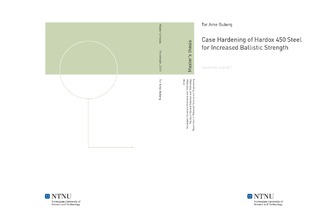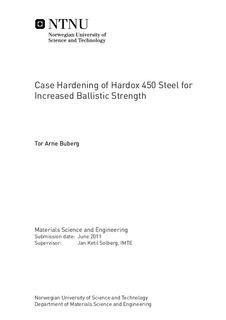| dc.description.abstract | AbstractSteel alloys are the material that is most used in protective constructions today. The reason is the overall good properties of steels, with its high strength and hardness, high ductility, high formability and relatively low cost compared to other materials. Even though armour steels are affordable, work is done to limit expenses from production or come up with new and less expensive alloys.Case hardening is a technique for production of steel with a very hard and durable surface while still maintaining a tough and ductile core. Case hardened products have hard, durable and fatigue resistant surfaces and tough and durable cores. Case hardening is typically applied to machine parts that are exposed to heavy wear and high loads such as gears, bearings, screws and nuts, shafts, etc In 2010, Lou et al. managed to significantly increase the penetration resistance of a low-cost steel (NVE36) by case hardening. Encouraged by this, Hans Magne Thorseth wrote his master s thesis Optimalisering av stål i beskyttelseskonstruksjoner in 2010. His attempt to improve the ballistic strength of Hardox 450 steel by case hardening did not have the desired results. The ballistic limit velocity was reduced from approximately 800 m/s for the original Hardox 450 to approximately 770 m/s for the case hardened steel. The probable reasons for the reduction of the ballistic limit velocity was a too low carbon content increase from the carburizing and thus a too low hardness increase, in addition to deterioration of the metal core properties from the heat treatment. The objective of this master s thesis was to improve the case hardening process used by Hans Magne Thorseth in his master s thesis.The improvement work was divided into two parts, a preliminary project work and this master thesis. The project was carried out in the autumn of 2010, and the aim was to find the optimum case hardening process to produce steel with improved ballistic properties. This involved testing of different carburizing potentials to increase the surface carbon content of the metal and to find carburizing heat treatments that would retain the core properties of the carburized steel. Based on the results from the preliminary project it seemed possible to produce case hardened steel with surface hardness over 1000 HV, but a slight reduction of core hardness was difficult to avoid.The present master s thesis was written during the spring of 2011. The key results from the preliminary project work were used to determine a range of case hardening courses. A total of 11 case hardening courses were tested, of which six courses employed carbon potential of 0.9% and five courses employed a carbon potential of 1.1%. Different hardening courses were tested, including direct hardening, a modified single hardening process and traditional and modified versions of double and triple hardening. Before the case hardening the plates were sandblasted to remove a corrosion-resistant primer that was applied to the plates. The primer was believed to limit the diffusion of carbon into the steel. In the preliminary project the primer was ground away and grinding was the preferred solution in this work as well, however, due to capacity issues sandblasting was employed.The ballistic limit velocity of the case hardened and the original Hardox 450 target plates were calculated from results obtained by ballistic experiments. The ballistic limit velocities of the case hardened samples, with approximately 787 m/s as the highest, were lower than that of the original Hardox 450, being approximately 800 m/s. Surface hardness measurements of the steel revealed a poor effect from the carburization, the hardest surface was measured at 735 HV. This could be explained by a probable surface decarburization of the original Hardox 450, which was discovered by microstructure examinations and hardness measurements. In contrary to in the preliminary project where this layer was ground away, the sandblasting did not remove the decarburized layer. Due to this, the case hardening did not have the desired effect on the steel surface, resulting in a too low surface hardness. The core hardness proved difficult to retain, the highest core hardness value obtained was below 460 HV, compared to the original Hardox 450 with core hardness of 475 HV. This could be another reason for the lower ballistic limit velocity of the carburized steel plates. However, the original Hardox 450 did not have the highest cross-sectional hardness integral value, so the ballistic properties probably also depend to some degree on ductility. A main reason for the superior ballistic limit velocity of the original Hardox 450 was therefore believed to be related to cracking of the rear side of the case hardened target plates during projectile penetration. The cracking seemed to be a result of the harder, and thus more brittle, outer surface layer. | nb_NO |

